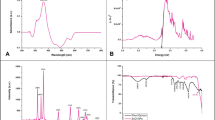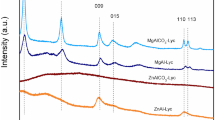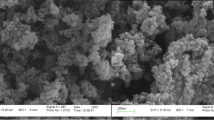Abstract
Lycopene, a phytonutrient of carotenoid category occurring in tomato and other fruits, has long been recognized for improving the health and in the prevention of chronic diseases such as cancer and metabolic and cardiovascular disorders. However, due to its hydrophobic nature, its bioavailability is low in systemic circulation thus creates difficulty in clinical application. To overcome this restriction, we have prepared lycopene nanoparticles to improve its bioavailability and further subjected them for assessing the antidiabetic activity in experimental animals. Lycopene nanoparticles (LNP) were prepared by nanoprecipitation method and characterized by UV-vis spectroscopy, Fourier-transform infrared (FTIR) spectroscopy, and scanning electron microscopy (SEM). Non-insulin-dependent diabetes mellitus (NIDDM) was induced in Wistar albino rats by intraperitoneal administration of streptozotocin (60 mg/kg). Lycopene (100 mg/kg) and its nanoparticle (LNP 25 mg/kg and 50 mg/kg) were given orally for 21 days as treatment protocol. Blood glucose level measured by a glucometer and various biochemical parameters, viz. cholesterol, triglycerides, LDL, HDL, VLDL, and in vivo antioxidant parameters, were measured by using diagnostic kits. Lycopene nano-suspension exhibited mean particle size and polydispersity index to be 100 ± 4.50 nm and 0.04 respectively, which exhibits uniform nano-formulation. In vivo antidiabetic studies showed a significant decrease (p<0.001) in elevated blood sugar levels and biochemical parameters via oral administration of LNP in a dose-dependent manner with prominent antioxidant effects. The promising results of the study showed that nano-preparation was found to be the most effective for antidiabetic activity due to amelioration of oxidative biomarker.








Similar content being viewed by others
References
Kawahito, S., Kitahata, H., & Oshita, S. (2009). Problems associated with glucose toxicity: role of hyperglycemia-induced oxidative stress. World J Gastroenterol, 15, 4137–4142. https://doi.org/10.3748/wjg.15.4137.
Britton, G., Liaaen-Jensen, S., & Pfander, H. (2004). Carotenoids. Basle: Birkhauser.
Gerster, H. (1997). The potential role of lycopene for human health. J Am Coll Nutr, 16, 109–126. https://doi.org/10.1080/07315724.1997.10718661.
Rao, A. V., & Agarwal, S. (1999). Role of lycopene as antioxidant carotenoid in the prevention of chronic diseases: a review. Nutrition Res, 19, 305–323. https://doi.org/10.1016/S0271-5317(98)00193-6.
Zhang, L. X., Cooney, R. V., & Bertram, J. S. (1991). Carotenoids enhance gap junctional communication and inhibit lipid peroxidation in C3H/10T1/2 cells: relationship to their cancer chemopreventive action. Carcinogenesis, 12, 2109–2114. https://doi.org/10.1093/carcin/12.11.2109.
Levy, J., Bosin, E., Feldman, B., Giat, Y., Miinster, A., Danilenko, M., & Sharoni, Y. (1995). Lycopene is a more potent inhibitor of human cancer cell proliferation than either alfa-carotene or beta carotene. Nutr Cancer, 24, 257–266. https://doi.org/10.1080/01635589509514415.
Lingen, C., Ernster, L., & Lindberg, O. (1959). The promoting effect of lycopene on the nonspecific resistance of animals. Exp Cell Res, 16, 384–393. https://doi.org/10.1016/0014-4827(59)90267-8.
Fawzi, W., Herrera, M. G., & Nestel, P. (2000). Tomato intake in relation to mortality and morbidity among Sudanese children. J Nutr, 130, 2537–2542. https://doi.org/10.1093/jn/130.10.2537.
Cumming, R. G., Mitchell, P., & Smith, W. (2000). Diet and cataract: the Blue Mountains Eye studies. Ophthalmology, 107, 450–456. https://doi.org/10.1016/s0161-6420(99)00024-x.
Jiang, W., Guo, M. H., & Hai, X. (2016). Hepatoprotective and antioxidant effects of lycopene on non-alcoholic fatty liver disease in rat. World J Gastroenterol, 22, 10180–10188. https://doi.org/10.3748/wjg.v22.i46.10180.
Biddle, M. J., Lennie, T. A., Bricker, G. V., Kopec, R. E., Schwartz, S. J., & Moser, D. K. (2015). Lycopene dietary intervention: a pilot study in patients with heart failure. J Cardiovasc Nurs, 30, 205–212. https://doi.org/10.1097/JCN.0000000000000108.
Graff, R. E., Pettersson, A., Lis, R. T., et al. (2016). Dietary lycopene intake and risk of prostate cancer defined by ERG protein expression. Am J Clin Nutr, 103, 851–860. https://doi.org/10.3945/ajcn.115.118703.
Wang, L., Liu, S., Pradhan, A. D., Manson, J. E., Buring, J. E., Gaziano, J. M., & Sesso, H. D. (2006). Plasma lycopene, other carotenoids, and the risk of type 2 diabetes in women. Am J Epidemiol, 164, 576–585. https://doi.org/10.1093/aje/kwj240.
Mishra SB, Pandey H, Pandey AC (2013) Nanosuspension of Phyllanthus amarus extract for improving oral bioavailability and prevention of paracetamol induced hepatotoxicity in Sprague–Dawley rats. Adv Nat Sci: Nanosci Nanotechnol, 4, 035007. http://iopscience.iop.org/article/10.1088/2043-6262/4/3/035007. Accessed 02 November 2020
Singh AK, Pandey H, Ramteke PW, Mishra SB (2019) Nano - suspension of ursolic acid for improving oral bioavailability and attenuation of type II diabetes: A histopathological investigation. Biocatalysis and Agricultural Biotechnology 22: 101433. https://doi.org/10.1016/j.bcab.2019.101433. Accessed 02 November 2020
Yen, F. L., Wu, T. H., Lin, L. T., Cham, T. M., & Lin, C. C. (2008). Nanoparticles formulation of Cuscuta chinensis prevents acetaminophen-induced hepatotoxicity in rats. Food Chem Toxicol, 46, 1771–1777. https://doi.org/10.1016/j.fct.2008.01.021.
Michael McClain, R., & Bausch, J. (2003). Summary of safety studies conducted with synthetic lycopene. Regul Toxicol Pharmacol, 37, 274–285. https://doi.org/10.1016/s0273-2300(03)00004-7.
Trumbo, P. R. (2005). Are there adverse effects of lycopene exposure? J Nutr, 135, 2060S–2061S. https://doi.org/10.1093/jn/135.8.2060S.
Mellert, W., Deckardt, K., Gembardt, C., Schulte, S., Van Ravenzwaay, B., & Slesinski, R. (2002). Thirteen-week oral toxicity study of synthetic lycopene products in rats. Food Chem Toxicol, 40, 1581–1588. https://doi.org/10.1016/s0278-6915(02)00113-8.
Mishra, S. B., Verma, A., Mukerjee, A., & Vijayakumar, M. (2012). Amaranthus spinosus L. (Amaranthaceae) leaf extract attenuates streptozotocin-nicotinamide induced diabetes and oxidative stress in albino rats: a histopathological analysis. Asian Pac J Trop Biomed, 2, S1647–S1652. https://doi.org/10.1016/S2221-1691(12)60470-5.
Mishra, S. B., Verma, A., & Vijayakumar, M. (2013). Preclinical evaluation of antihyperglycemic and antioxidant action of Nirmali (Strychnos potatorum) seeds in streptozotocin nicotinamide-induced diabetic Wistar rats: a histopathological investigation. Biomark Genom Med, 5, 157–163. https://doi.org/10.1016/j.bgm.2013.07.010.
Jeon, S. M., Song, S. H., Jang, M. K., Kim, Y. H., Nam, K. T., Jeong, T. S., Park, Y. B., & Choi, M. S. (2002). Comparison of antioxidant effects of naringin and probucol in cholesterol-fed rabbits. Clin Chem Acta, 317, 181–190. https://doi.org/10.1016/s0009-8981(01)00778-1.
Haluzik, M., & Nedvidkova, J. (2000). The role of nitric oxide in the development of streptozotocin-induced diabetes mellitus: experimental and clinical implications. Physiol Res, 49, s37–s42.
Baynes, J. W. (1995). Reactive oxygen in the aetiology and complications of diabetes. In C. Ioannides & P. R. Flatt (Eds.), Drug, diet, and disease vol 2: Mechanistic approach to diabetes (pp. 203–231). Hertfordshire: Ellis Horwood.
Sugiura, M., Nakamura, M., Ikoma, Y., Yano, M., Ogawa, K., Matsumoto, H., Kato, M., Ohshima, M., & Nagao, A. (2005). High serum carotenoids are inversely associated with serum gamma-glutamyltransferase in alcohol drinkers within normal liver function. J Epidemiol, 15, 180–186. https://doi.org/10.2188/jea.15.180.
Coyne, T., Ibiebele, T. I., Baade, P. D., Dobson, A., McClintock, C., Dunn, S., Leonard, D., & Shaw, J. (2005). Diabetes mellitus and serum carotenoids: findings of a population-based study in Queensland, Australia. Am J Clin Nutr, 82, 685–693. https://doi.org/10.1093/ajcn.82.3.685.
Wang, L., Liu, S., Manson, J. E., Gaziano, J. M., Buring, J. E., & Sesso, H. D. (2006). The consumption of lycopene and tomato-based food products is not associated with the risk of type 2 diabetes in women. J Nutr, 136, 620–625. https://doi.org/10.1093/jn/136.3.620.
Patel, G., & Misra, A. (2011). Oral delivery of proteins and peptides: concepts and applications. In A. Misra (Ed.), Challenges in delivery of therapeutic genomics and proteomics (1st ed., pp. 481–529). London: Elsevier.
Recharla, N., Riaz, M., Ko, S., & Park, S. (2017). Novel technologies to enhance the solubility of food - derived bioactive compounds: a review. J Funct Foods, 39, 63–73. https://doi.org/10.1016/j.jff.2017.10.001.
Skoog, D. A., Holler, F. J., & Nieman, T. A. (1998). Principles of instrumental analysis. Boston: Thomson.
Takehara, M., Nishimura, M., Kuwa, T., et al. (2014). Characterization and thermal isomerization of (all-E)-lycopene. J Agric Food Chem, 62, 264–269. https://doi.org/10.1021/jf404497k.
Gary, A., & Grundy, S. M. (1990). Management of dyslipidemia in NIDDM. Diab Care, 13, 153–169. https://doi.org/10.2337/diacare.13.2.153.
Cooney, G. J., Thompson, A. L., Furler, S. M., Ye, J., & Kraegen, E. W. (2002). Muscle long chain acyl CoA esters and insulin resistance. Ann N Y Acad Sci, 967, 196–207. https://doi.org/10.1111/j.1749-6632.2002.tb04276.x.
Samuel, V. T., & Shulman, G. I. (2012). Mechanisms for insulin resistance: common threads and missing links. Cell, 148, 852–871. https://doi.org/10.1016/j.cell.2012.02.017.
Britton, G. (1995). Structure and properties of carotenoids in relation to function. FASEB J, 9, 1551–1558. https://doi.org/10.1096/fasebj.9.15.8529834.
DiMascio, P., Kaiser, S., & Sies, H. (1989). Lycopene as the most effective biological carotenoid singlet oxygen quencher. Arch Biochem Biophys, 274, 532–538. https://doi.org/10.1016/0003-9861(89)90467-0.
Stahl, W., & Sies, H. (2003). Antioxidant activity of carotenoids. Mol Aspects Med, 24, 345–351. https://doi.org/10.1016/s0098-2997(03)00030-x.
Wertz, K., Siler, U., & Goralczyk, R. (2004). Lycopene: modes of action to promote prostate health. Arch Biochem Biophys, 430, 127–134. https://doi.org/10.1016/j.abb.2004.04.023.
El-Missiry, M. A., & El-Gindy, A. M. (2000). Amelioration of alloxan induced diabetes mellitus and oxidative stress in rats by oil of Eruca sativa seeds. Ann Nutr Metab, 44, 97–100. https://doi.org/10.1159/000012829.
Fuhrman, B., Elis, A., & Aviram, M. (1997). Hypocholesterolemic effect of lycopene and beta-carotene is related to suppression of cholesterol synthesis and augmentation of LDL receptor activity in macrophages. Biochem Biophys Res Commun, 233, 658–662. https://doi.org/10.1006/bbrc.1997.6520.
Heber, D., & Lu, Q. Y. (2002). Overview of mechanisms of action of lycopene. Exp Biol Med, 227, 920–923. https://doi.org/10.1177/153537020222701013.
Acknowledgments
The authors are grateful to Prof. Alok Mukerjee, Principal, United Institute of Pharmacy, Prayagraj, for providing an animal house facility to accommodate the animals and carrying out the pharmacological activity. We acknowledge the contribution of Mrs. Shradhanjali Singh, Associate Professor, United Institute of Pharmacy, for serving their practical hands in spectroscopic studies and interpretation of data.
Data and Materials Availability
Not applicable.
Code Availability
Not applicable.
Funding
The authors did not receive support from any organization for the submitted work.
Author information
Authors and Affiliations
Corresponding author
Ethics declarations
Research Involving Humans and Animals Statement
All applicable international, national, and/or institutional guidelines for the care and use of animals were followed. All procedures performed in studies involving animals were in accordance with the ethical standards of the institution or practice at which the studies were conducted (REG. No: UIP/IAEC/Nov/2019/04).
Conflict of Interest
None.
Informed Consent
The consent of both the authors have taken to publish this study in this journal.
Additional information
Publisher’s Note
Springer Nature remains neutral with regard to jurisdictional claims in published maps and institutional affiliations.
Rights and permissions
About this article
Cite this article
Mishra, S.B., Kumari, N. Engineering of Crystalline Nano-Suspension of Lycopene for Potential Management of Oxidative Stress–Linked Diabetes in Experimental Animals. BioNanoSci. 11, 345–354 (2021). https://doi.org/10.1007/s12668-021-00843-4
Accepted:
Published:
Issue Date:
DOI: https://doi.org/10.1007/s12668-021-00843-4




